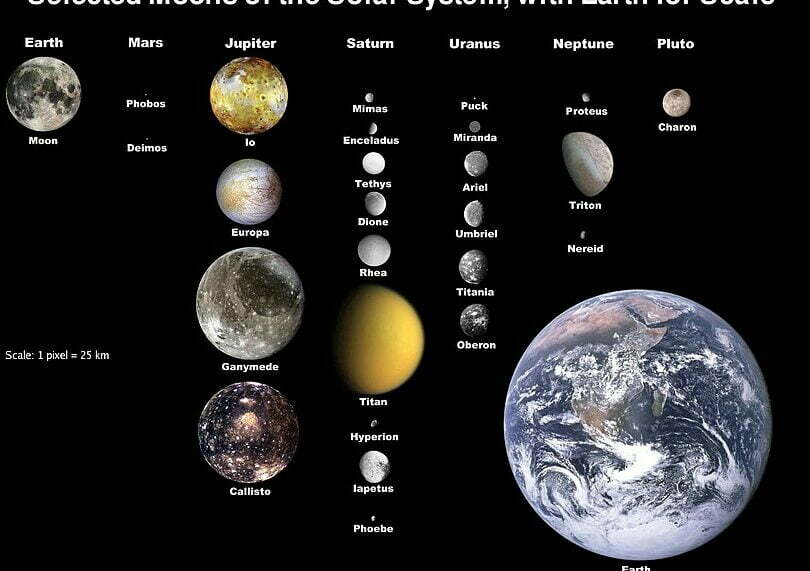Out of all the planets in the solar system, Jupiter holds the title for being the heaviest. In fact, the combined mass of all the other celestial bodies is only 2.5 times less than that of this massive gas giant, which is named after the powerful Roman god of thunder. While much about Jupiter’s interior remains a mystery, its satellites have been extensively studied. As of July 2019, there are a total of 79 known satellites orbiting Jupiter. These satellites vary in size, with most being small boulders measuring several kilometers in diameter, while others are much larger moons that have piqued the interest of astronomers.
Discovery History
The observation of the celestial behemoth has been a practice since ancient times. Initially, people relied on their naked eyes to study Jupiter, specifically noting its distinctive luminosity during particular periods, which were subsequently referred to as oppositions. It was in January 1610 when Galileo directed his inaugural telescope towards the colossal planet and distinguished three moons that orbited it. Another satellite was subsequently found. These four significant satellites of Jupiter came to be known as the Galilean satellites, although the German astronomer Simon Marius also staked a claim to their discovery.
Following subsequent observations made from the ground, it became possible to identify an additional 9 satellites by 1970. In the year 1978, three new moons were detected during the flyby of Voyager 1 near the planet. Since 1999, with the advancements in telescopes of the new generation, scientists have been able to discover 47 more satellites and confirm the presence of a dust ring system. The Hubble telescope and the Galileo spacecraft, operating as an artificial satellite from 1995 to 2003, have made significant contributions to the field of Jupiterian research.
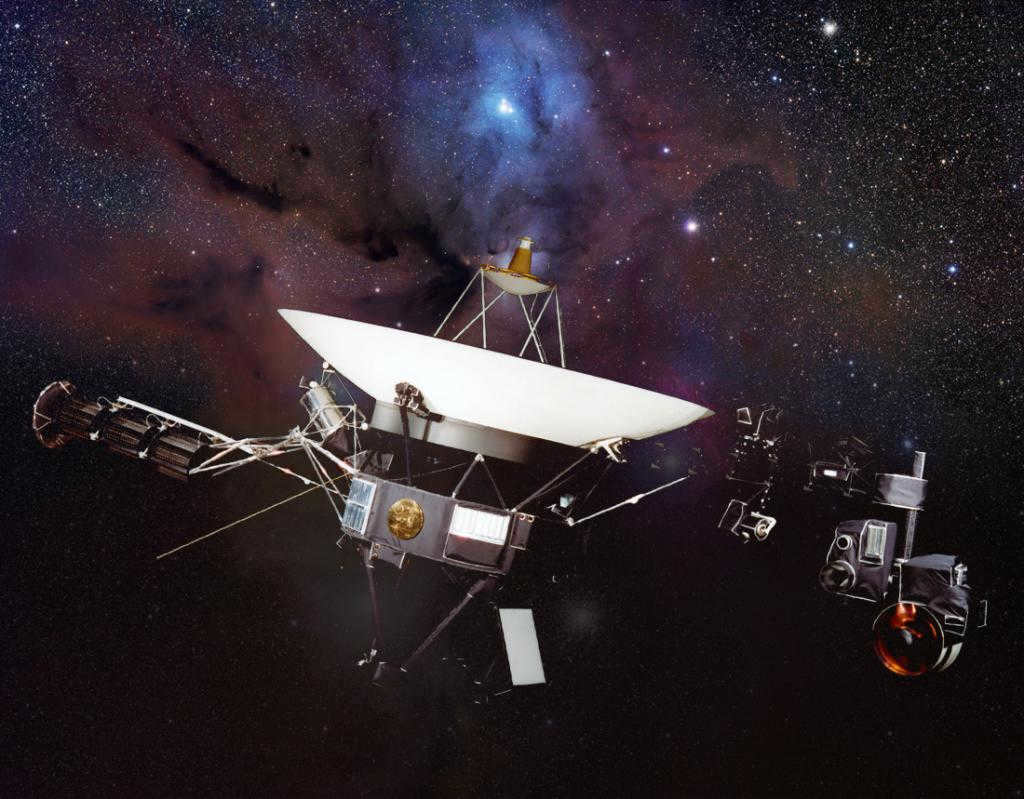

Satellite classification
Jupiter’s satellites can be classified into three main groups: primary moons, inner moons, and outer moons. The primary moons are the largest and most prominent satellites. The inner moons are smaller in size and orbit closer to the surface of the planet. They follow orbits that are approximately 20 times the radius of Jupiter. The outer moons, on the other hand, orbit at even greater distances, up to 50 million km from the center of Jupiter.
Inner and outer
The inner moons orbit the giant in circular paths within its equatorial plane. There are three smaller bodies with radii ranging from 20 to 250 km, as well as the moon Amalthea. The two moons closest to the giant are Metida and Adrastea, which follow regular orbits near the outer edge of the rings.
The outer group of satellites is more numerous, with at least 59 objects. These bodies have irregular shapes and none of them exceed 170 km in size. They move along elliptical orbits, with some of them inclined relative to the equatorial plane. Additionally, some of these moons move in a retrograde direction, opposite to the motion of the giant planet and its other moons.
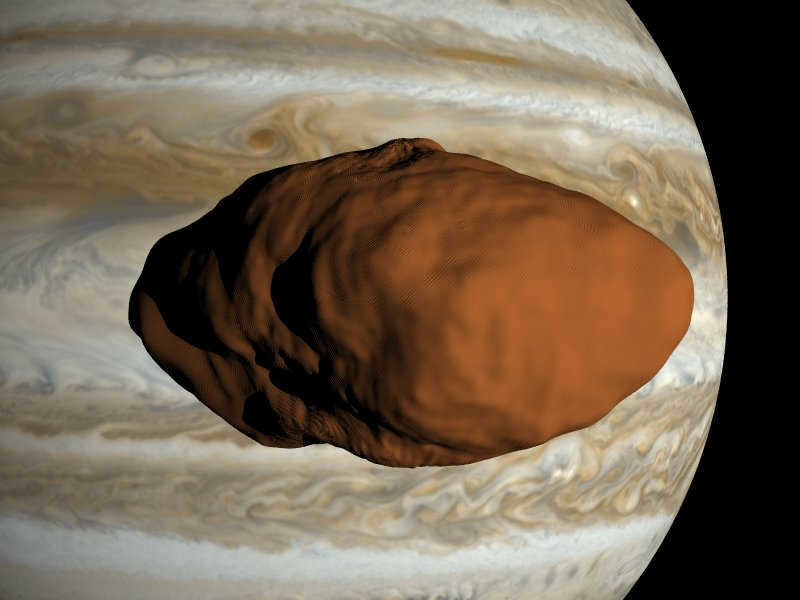
It is believed that certain outer satellites of Jupiter were once a unified body that broke apart due to a collision with another celestial object. These satellites now move in proximate orbits alongside each other.
The subgroup consists of small-sized objects that orbit in highly elliptical paths, located at a considerable distance from the planet’s core. These bodies were created either as a result of collisions with larger moons or by being captured by Jupiter’s gravitational pull. Since their formation, they have undergone minimal changes, making them valuable in providing insights into the characteristics of the solar system.
Moons of Jupiter
The Galilean satellites are a group of significant moons that were formed at the same time as Jupiter, but they resemble planets in the Earth’s group. These moons orbit Jupiter in circular paths, ranging from 420 thousand to 2 million km from the center of the planet’s core. The order of their distance from Jupiter is Io, Europa, Ganymede, and Callisto. They are each at least 1.5 times larger than Earth’s Moon.
The periods of rotation for these satellites are related in a 1/2/4/8 ratio, which is a result of resonance. The gravitational forces exerted by the larger moons cause Jupiter’s rotation on its axis to slow down. The axial rotation of the moons is also affected, causing them to always face the planet with the same side.
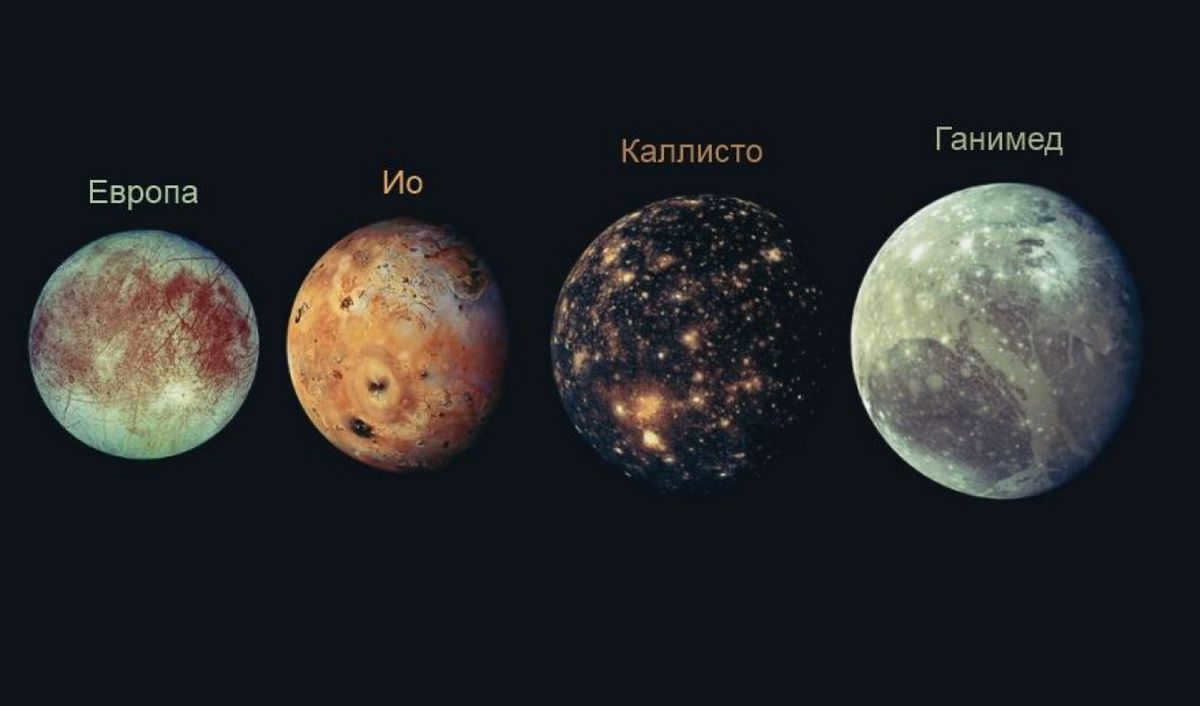

Names and physical characteristics
The density of the satellites decreases on average as their orbits move further from the planet.
Research has provided insight into the composition and physical attributes of the main moons, which are listed below:
- Callisto. This celestial body is the least dense, consisting of ice and rock. It lacks tectonic processes but features numerous craters surrounded by fissures. Its mass is 1.1×10^23 kg, and its size is 4,821 km.
- Io. This satellite possesses an iron core, a liquid mantle, and a crust that is 10-40 km thick. Tectonic processes are active on Io, with approximately 400 functioning volcanoes. Its mass is 8.9×10^22 kg, and its size is 3,642 km.
- Ganymede. Jupiter’s largest moon, Ganymede, would be classified as a planet if it orbited the Sun independently. This celestial body possesses a core and traces of oxygen in its atmosphere. Beneath a layer of ice lies an ocean. It has a mass of 1.48⋅10²³ kilograms and measures approximately 5,260 kilometers in size.
- Europa. The smallest of the major moons, Europa, contains a metallic core at its center. Its surface is composed of water vapor and ice, and scientists believe there is a salty ocean beneath. This moon is of great interest for studying and searching for extraterrestrial life. Europa has a mass of 4.8×10²² kg and measures about 3,122 kilometers in size.
Experts are currently studying satellites not only from the Galilean group. One of the inner satellites of particular interest is Amalthea, which is dark red in color and has unique characteristics not found in other celestial bodies within the solar system. Amalthea measures 250x146x128 km and its coloring is believed to be a result of mineral inclusions in its ice and sulfur settling from the nearby volcanoes of its neighbor, Io. However, there is also a theory that suggests Amalthea was captured by Jupiter’s gravity.
Another elusive satellite is Metida, measuring 60x40x34 km, which orbits Jupiter at a faster rate than the planet rotates on its axis. Its unusual orbit makes it difficult for scientists to study. The most distant of the inner moons is Phoebe, measuring 116x98x84 km. It is positioned in space in such a way that its inner end always faces Jupiter.
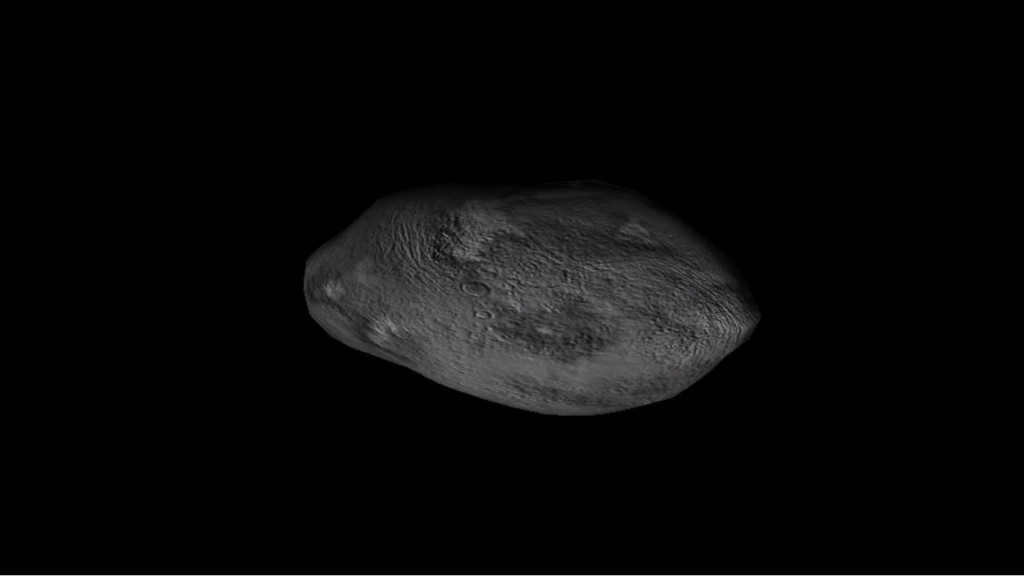
The Himalia and Ananke groups used to be asteroids until they were pulled in by the planet’s gravitational force. The only satellites that are not part of either group are Themisto and Carlo.
Orbital Characteristics
The table below, provided by the Institute of Space Research of the Russian Academy of Sciences, presents orbital information for the gas giant’s satellites:
| Name of satellite | Major semi-axis (km) | Orbital period (days) | Year of discovery |
| Major Galilean satellites | |||
| Io | 421,700 | +1.77 | 1610 |
| Callisto | 1,882,709 | +16.69 | 1610 |
| Ganymede | 1,070,412 | +7.15 | 1610 |
| Europa | 671,034 | +3.55 | 1610 |
| Inner group of Amalthea satellites | |||
| Metis | 127,690 | +7 h 4 m 29 s | 1980 |
| Adrastea | 128,690 | +7 h 9 m 30 s | 1979 |
| Amalthea | 181,366 | +11 h 57 m 23 s | 1892 |
| Fiva | 221,889 | +16 h 11 m 17 s | 1979 |
| External group of Carlo satellites | |||
| Carlo | 17,144,873 | +458.62 | 2003 |
| Near external group of Himalia satellites | |||
| Leda | 11,187,781 | +241.75 | 1974 |
| Himalia | 11,451,971 | +250.37 | 1904 |
| Lysithea | 11,740,560 | +259.89 | 1938 |
| Elara | 11,788,034 | +261.14 | 1905 |
Jupiter, with its strong gravity and magnetic field, possesses a considerable amount of satellites, allowing for multiple objects to be studied in the realm of scientific research. Due to the vast distance and limitations in technology, the exact number of Jupiter’s satellites remains uncertain. However, as advancements continue to be made, humanity gains a greater understanding of this gas giant’s satellite system.
Jupiter is truly a colossal presence in the solar system. Its immense size surpasses the combined mass of all the other planets by over two-fold.
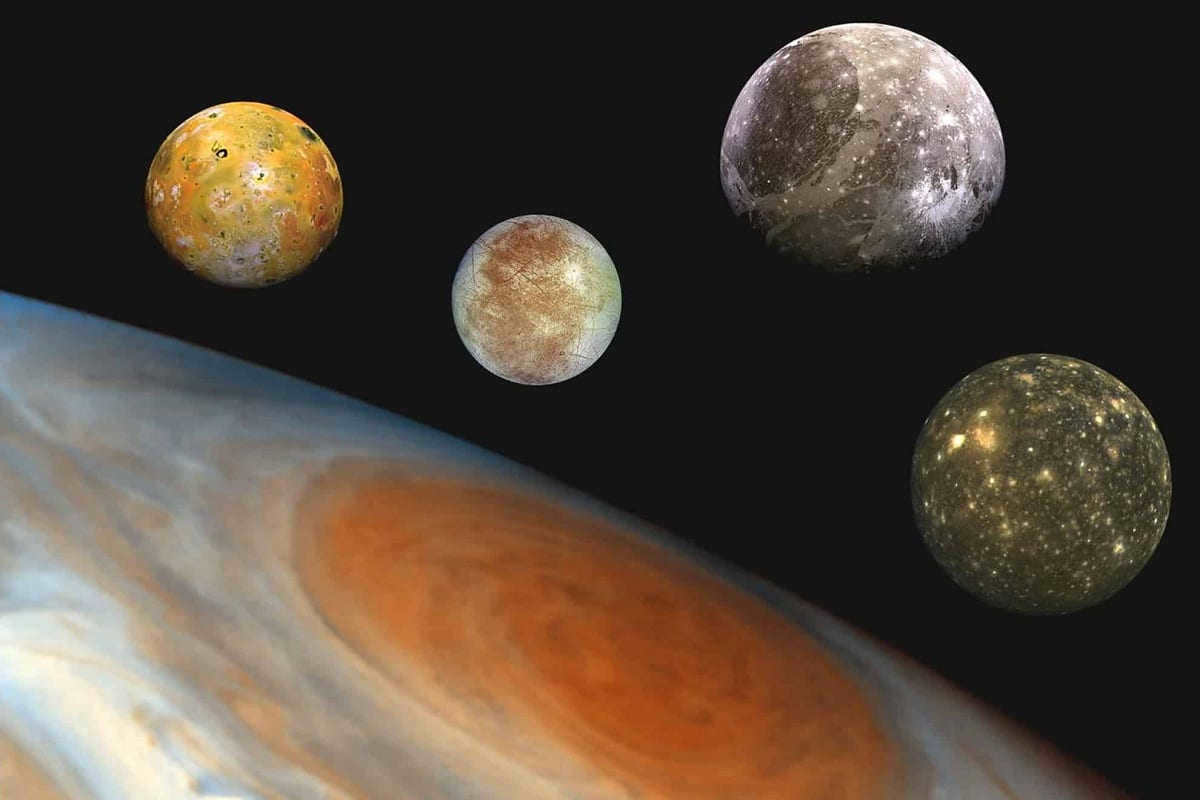
Because of its immense size, Jupiter has its own system of satellites orbiting around it. Currently, there are 80 known satellites, but some scientists believe that there may be at least 100 in total.
Jupiter’s satellites can be classified into two main types:
Internal satellites are those that orbit closest to the planet. They can be further divided into two subgroups:
- Almatheans are the closest celestial bodies to Jupiter, with sizes of up to 250 km.
- Galileo’s satellites are the largest satellites and are named after their discoverer. Their brightness can be observed on a clear night, even without a telescope. However, a basic telescope is sufficient for a more detailed study of these satellites.
The moons of Galileo
Ganymede
is one of the largest moons in the solar system.
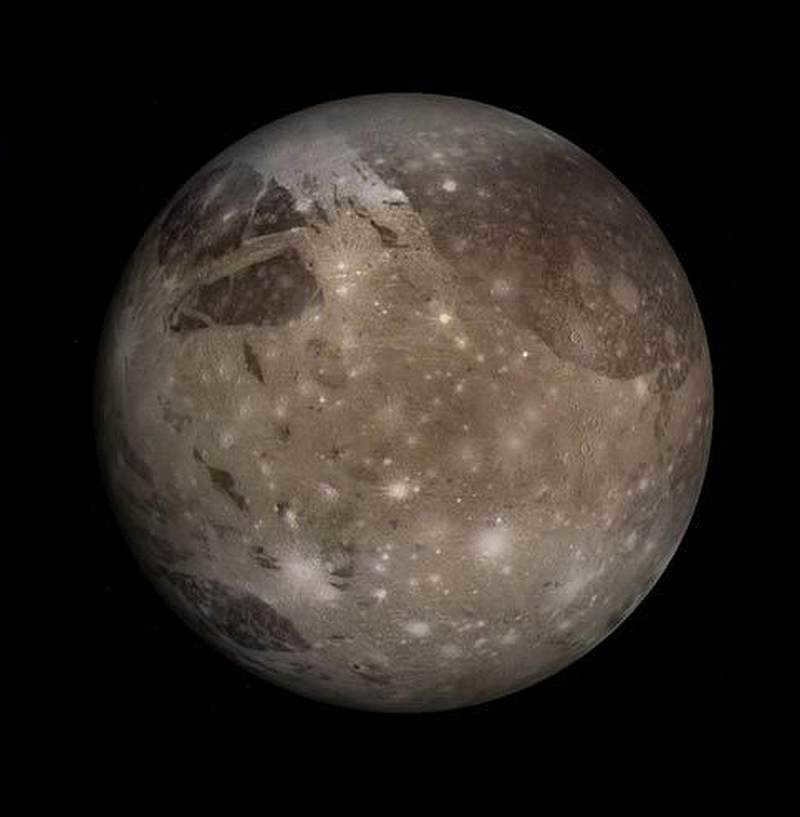
Ganymede, the largest satellite in the solar system and not only of Jupiter, could have been a fully-fledged planet if it hadn’t been caught in Jupiter’s gravitational field. Its surface is covered in a thick layer of ice mixed with rock.
Beneath the icy crust lies the mantle, with an iron core at its center. Approximately half of the terrain is filled with craters, while the remaining areas are adorned with light-colored patterns. The atmosphere is thin, with minimal amounts of oxygen.
Ganymede completes one rotation around Jupiter every 7 days. The poles of the satellite feature polar caps, which are formed due to the unique characteristics of its magnetosphere.
Callisto
There is a belief that a vast ocean lies beneath the 800-kilometer-wide ice crust on Callisto.
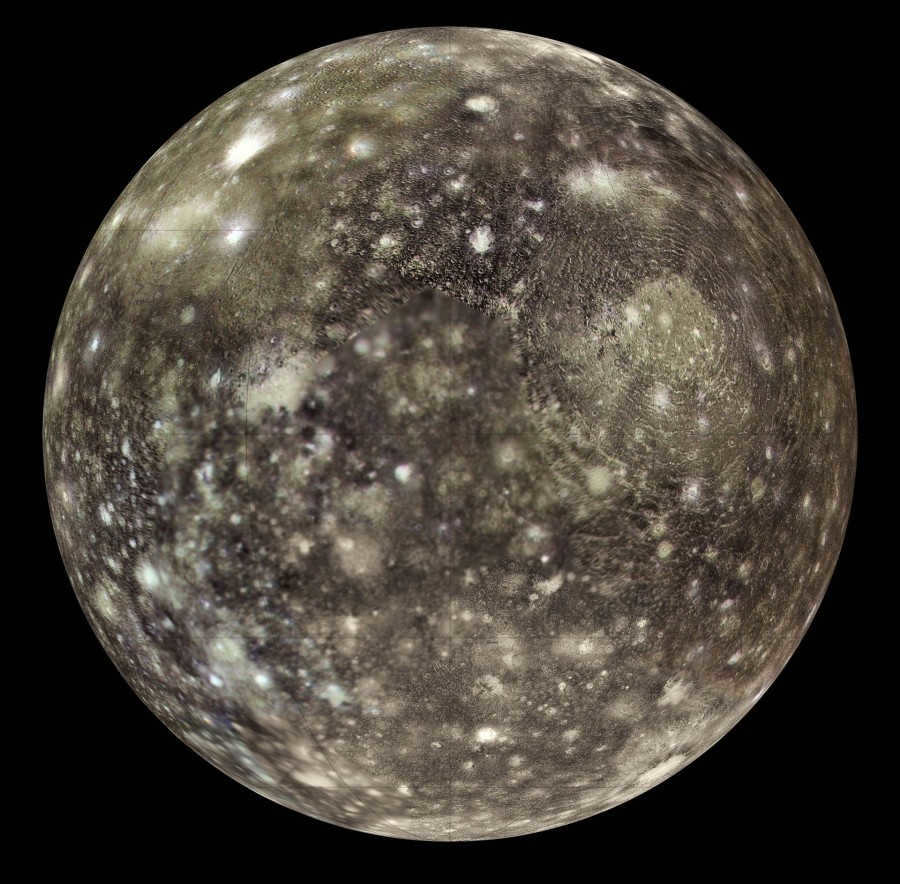
Ranking third among the largest satellites in the solar system, Callisto is only surpassed by Ganymede and Titan. It is situated nearly 2 million kilometers away from Jupiter, which helps protect it from excessive radiation.
At its core, Callisto has a small rocky center, while its surface is covered by a thick icy crust that measures up to 300 km in thickness. The landscape is rugged, displaying numerous traces of meteorite impacts.
The most prominent crater, Valhalla, stretches out over 1800 km. The atmosphere on Callisto is thin, with carbon dioxide being the dominant component. Similar to Ganymede, scientists believe that there may be an ocean beneath Callisto’s lithosphere. It takes 16 days for Callisto to complete one revolution around Jupiter.
Geologically speaking, Callisto is known for its stability. There are no volcanic eruptions or lithospheric plate shifts taking place on this satellite.
Europe
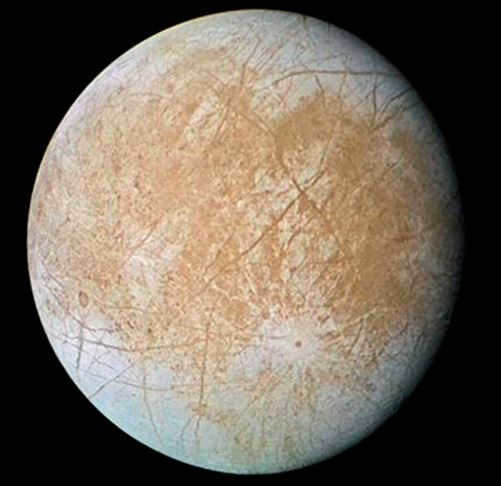
The satellite of Jupiter known as Europa is composed of an iron core, mantle, and a silicate-water upper layer. It has a flat surface, with research vehicle images revealing minor cracks and faults.
Europa experiences extremely low temperatures, dropping to as low as -200 degrees Celsius. It takes approximately 3.5 days for Europa to complete one revolution around Jupiter.
Europa is of significant interest for scientific study due to its relatively thin icy crust, measuring only 10 to 30 km in thickness. Below this crust, there is substantial evidence of a salty ocean, making its composition potentially very similar to that of Earth.
Io
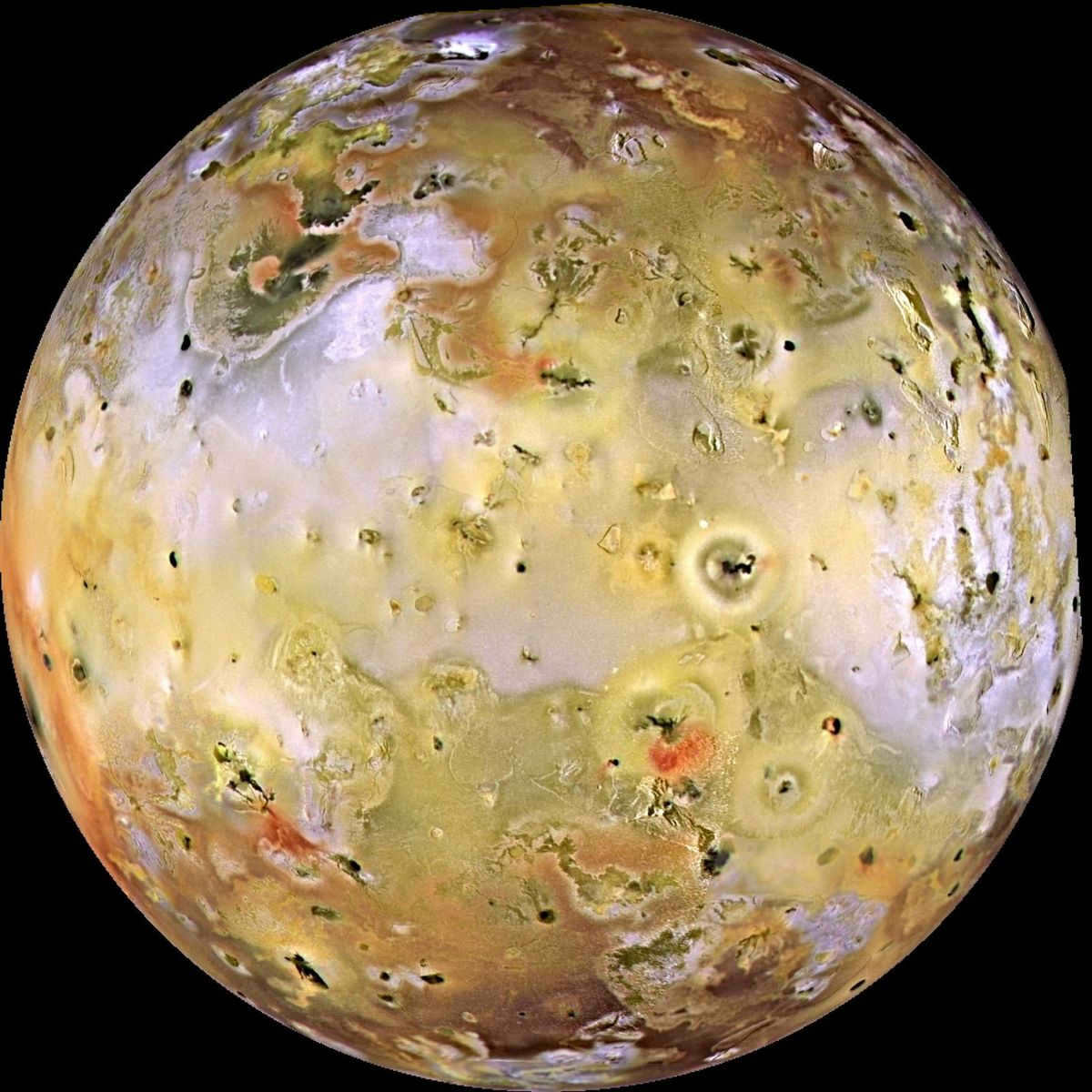
Io differs from the Galilean satellites in that it resembles the terrestrial planets. It lacks an icy crust and is primarily composed of silicates and metals. Another similarity is its active volcanoes.
Io is home to over 400 volcanoes, making it the most geologically active object in the solar system. The landscape undergoes regular changes due to constant cataclysms. Earthquakes give rise to towering mountains and deep fissures in the crust.
These volcanoes spew sulfur up to a height of 500 kilometers, while lava can spread the same distance. Temperatures can plummet to -200 degrees Celsius, yet the area around the volcanic vent remains heated to 3000 degrees Celsius.
Satellites, Rings, Exploration, and Photographs
Jupiter has captivated astronomers since it was first observed through early telescopes over 400 years ago. This stunning gas giant is characterized by its swirling clouds, enigmatic Great Red Spot, diverse array of satellites, and numerous distinctive features.

The planet Jupiter is truly remarkable due to its immense size. In terms of mass, volume, and area, it holds the prestigious title of being the largest planet in the solar system. This fact has been known to humanity since ancient times, as Jupiter was recognized and revered in various cultures.
Fascinating Information about Jupiter
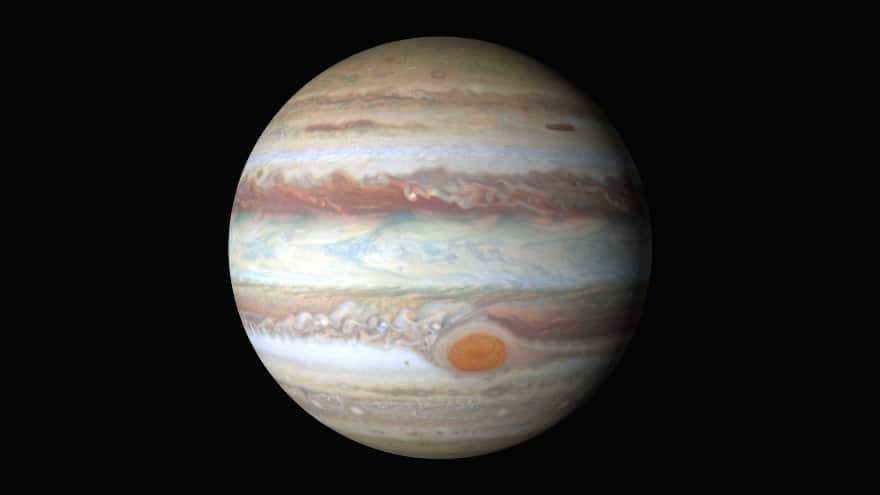
- In terms of brightness, Jupiter surpasses the Sun, the Moon, and Venus. It is one of the top five visible planets without the need for instruments.
- Mentions of Jupiter date back to the 7th-8th centuries BC. It was named after the supreme deity in the Greek pantheon (known as Zeus). In Mesopotamia, it was known as Marduk, and in Germanic tribes, it was called Thor.
- Jupiter completes one full rotation on its axis in just 9 hours and 55 minutes. This rapid rotation causes the planet to have a flattened shape at its poles and an expanded equatorial line.
- The upper layer of Jupiter’s atmosphere is divided into cloud belts and zones. These regions contain crystals of ammonia, sulfur, and their mixtures.
- The photographs reveal an enormous storm known as the Great Red Spot, which has been raging for 350 years without ceasing. Its size is so immense that it could easily engulf three entire Earths.
- Beneath the layer of atmosphere, there lie various layers consisting of gaseous and liquid hydrogen, as well as a solid core composed of ice, rock, and metals.
- Among Jupiter’s many satellites, the largest ones include Ganymede, Callisto, Io, and Europa. Ganymede, with a diameter of 5268 km, is even bigger than the planet Mercury.
- Jupiter’s rings are relatively thin and primarily composed of dust particles that have been ejected from its moons during collisions with comets or asteroids. These rings begin at a distance of 92000 km from the planet and extend up to 225000 km. They have a thickness ranging from 2000 to 12500 kilometers.
- Notable spacecraft that have explored or are planned to explore Jupiter include the Pioneers 10 and 11, Voyagers 1 and 2, Galileo, Cassini, Willis, and New Horizons. Future missions may continue to focus on satellites.
Dimensions, weight, and path
Mars possesses a weight of 1.8981 x 10 27 kg, a capacity of 1.43128 x 10 15 km 3 , a surface area of 6.1419 x 10 10 10 km 2 , and an average circumference of 4.39264 x 10 5 km. To provide you with a sense of scale, the planet boasts a diameter that is 11 times greater than our own and a mass that is 2.5 times larger than all of the planets in our solar system combined.
Properties of Jupiter’s Physical Appearance
Jupiter is classified as a gas giant, which means it has a density of 1.326 g/cm3, less than a quarter of Earth’s density. This low density indicates that Jupiter is primarily composed of gases, although there is still ongoing scientific discourse regarding the exact composition of its core.
A skilled tarot reader can provide insights into the future and address questions about the progression of relationships and the best course of action to take.

This planet is located at an average distance of 778,299,000 km from the Sun, although this distance can range from 740,550,000 km to 816,040,000 km. It takes approximately 11.8618 years for the planet to complete one orbit around the Sun, resulting in a year that lasts about 4332.59 days.
Jupiter’s path and spinning
| 7.405-10.8 km (4,950 a. u.) |
| 8.165-10 8 km (5.458 a. u.) |
| 7.785-10.8 km (5.204 a. u.) |
However, Jupiter possesses one of the swiftest axial rotations, completing a full rotation in just 9 hours, 55 minutes, and 30 seconds. As a result, a year on Jupiter lasts about 10,475.8 solar days.
Structure and Surface
Jupiter is comprised of both gaseous and liquid substances, making it the largest of the gas giants. It can be divided into two distinct layers: an outer atmospheric layer and an inner layer. The atmosphere is primarily composed of hydrogen, which makes up around 88-92% of the planet’s composition, with helium making up the remaining 8-12%.
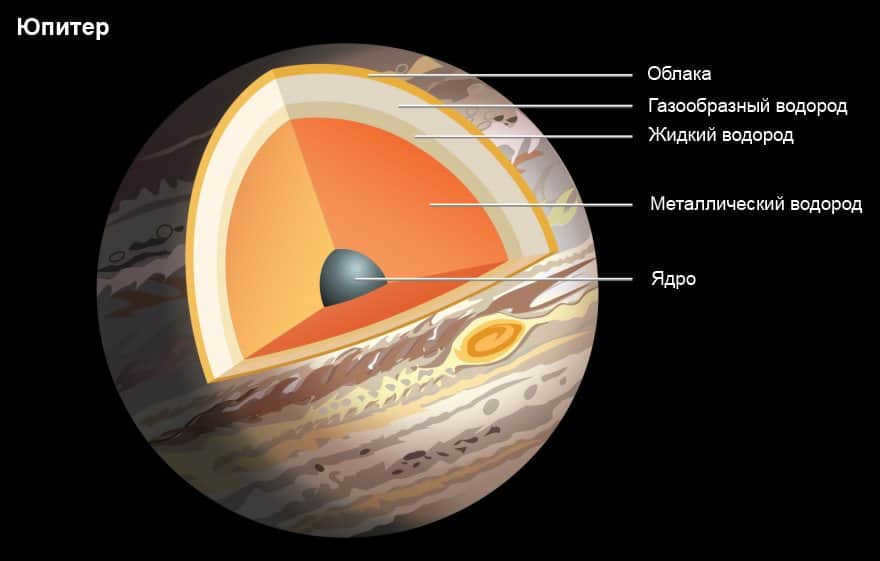

The composition of Jupiter’s interior is characterized by the presence of various gases and materials. Methane, water vapor, silicon, ammonia, and benzene can all be detected within the planet. Additionally, small amounts of hydrogen sulfide, carbon, neon, ethane, oxygen, sulfur, and phosphine are also present.
The interior of Jupiter is composed of dense materials, primarily hydrogen (71%), helium (24%), and other elements (5%). The core of the planet is believed to consist of a dense mixture of metallic hydrogen in a liquid state, along with helium and an outer layer of molecular hydrogen. While it is speculated that the core may have a rocky composition, conclusive data regarding its nature is currently unavailable.
In 1997, scientists made a groundbreaking discovery when they calculated the presence of a core within Jupiter. The data suggested that this core could weigh between 12-45 times the mass of Earth and make up about 4-14% of Jupiter’s total mass. This finding is also supported by planetary models, which propose that the formation of gas giants like Jupiter required the presence of a solid core made of rock or ice. However, it is possible that convection currents and the presence of glowing liquid hydrogen have caused the core to shrink in size.
As one moves closer to the core, the temperatures and pressures increase dramatically. It is estimated that at the surface of Jupiter, the temperatures will reach a scorching 67°C with a pressure of 10 bar. At the phase transition, which is closer to the core, temperatures will soar to a staggering 9700°C with a pressure of 200 GPa. Finally, near the core itself, temperatures will reach an astonishing 35700°C with pressures ranging from 3000-4500 GPa.
Satellites
It has been revealed that there exists a cluster of 79 satellites (as of 2019) in the vicinity of the planet. Out of these, four of the largest ones have been named Galilean, owing to the fact that they were first identified by Galileo Galilei. These four satellites are Io (known for its solid active volcanoes), Europa (renowned for its massive subsurface ocean), Ganymede (acknowledged as the largest satellite within the system), and Callisto (notable for its subsurface ocean and ancient surface materials).
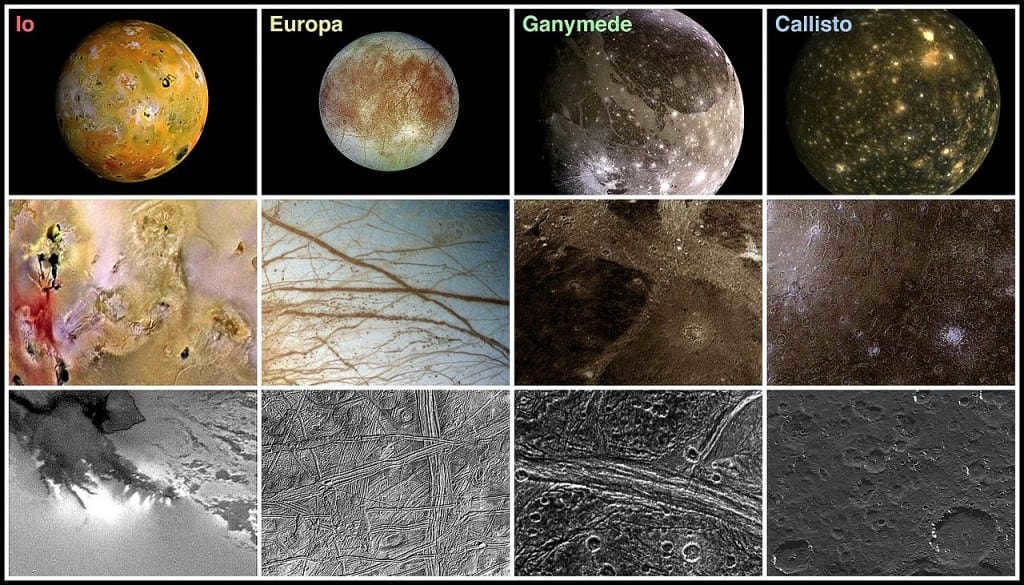

The surfaces of the four primary moons of Jupiter, namely Io, Europa, Ganymede, and Callisto, can be observed in detail.
Additionally, there is a group known as Amalthea, consisting of four smaller satellites with diameters less than 200 km. These satellites are located approximately 200,000 km away from Jupiter and have an orbital inclination of 0.5 degrees. The members of the Amalthea group are Metis, Adrastea, Amalthea, and Phoebe.
A skilled tarot reader will provide answers to the following questions:
What does the future hold for you? How will your relationships develop? What is the best course of action to take?

There are also numerous irregular moons that are smaller in size and have more elliptical orbits. These moons can be categorized into groups based on their similar size, composition, and orbital characteristics.
Atmosphere and Temperature
The well-known auroras can be observed at the northern and southern poles of Jupiter. However, on Jupiter, these auroras are much more intense and rarely cease. This spectacular display is influenced by the strong radiation, magnetic field, and emissions from the volcanoes on Jupiter’s moon, Io.
The composition of Jupiter’s atmosphere
There are remarkable weather conditions as well. The wind reaches speeds of 100 m/s and can even reach up to 620 km/h. Within just a few hours, a massive storm can form, spanning thousands of kilometers in diameter. The Great Red Spot was first observed in the 1600s and remains active, although it is gradually shrinking.
The planet is concealed by clouds composed of ammonia and ammonium hydrosulfate. These clouds are located in the tropopause and are referred to as tropical regions. This layer can extend up to 50 kilometers in height. There may also exist a layer of water clouds, as indicated by lightning flashes that are 1000 times more intense than our own.
Exploration history
The planet’s existence has been known for a long time due to its size, making it visible in the sky without the need for instruments. The first mentions of the planet appeared in Babylon during the 7th-8th century BC. In the 2nd century, Ptolemy developed his geocentric model, which calculated the orbital period around Earth to be 4332.38 days. Mathematician Aryabhata used this model in 499 and obtained a result of 4332.2722 days.
In 1610, Galileo Galilei used his instrument to observe the gas giant for the first time. During his observation, he also discovered four of its largest satellites. This discovery was significant as it provided evidence in support of the heliocentric model.

Galileo is seen gesturing toward the heavens while standing in Venice
Cassini utilized a new telescope during the 1660s in order to observe and study the markings and bright streaks on the planet. His findings revealed that Jupiter is a slightly flattened sphere. By 1690, he had also determined the planet’s rotational period and the differential rotation of its atmosphere. The intricate details of the Great Red Spot were initially documented by Heinrich Schwabe in 1831.
In 1892, E. E. Bernard made the observation of the fifth moon. This moon, called Almathea, was the final satellite to be discovered through visual survey. Rupert Wildt conducted a study on the absorption bands of ammonia and methane in 1932. Additionally, in 1938, he tracked three long-lasting “white ovals”. Initially, these ovals were separate formations, but in 1998, two of them merged into a single object, absorbing the third in 2000.
A skilled tarot reader will provide answers to the following questions:
What does the future hold for you? How will your relationships unfold? What is the best decision to make?

The exploration of space using radio telescopes commenced during the 1950s. In 1955, the initial transmissions were detected, consisting of periodic bursts of radio waves that corresponded to the rotation of celestial bodies. These signals provided invaluable data for determining the velocity of these planets.
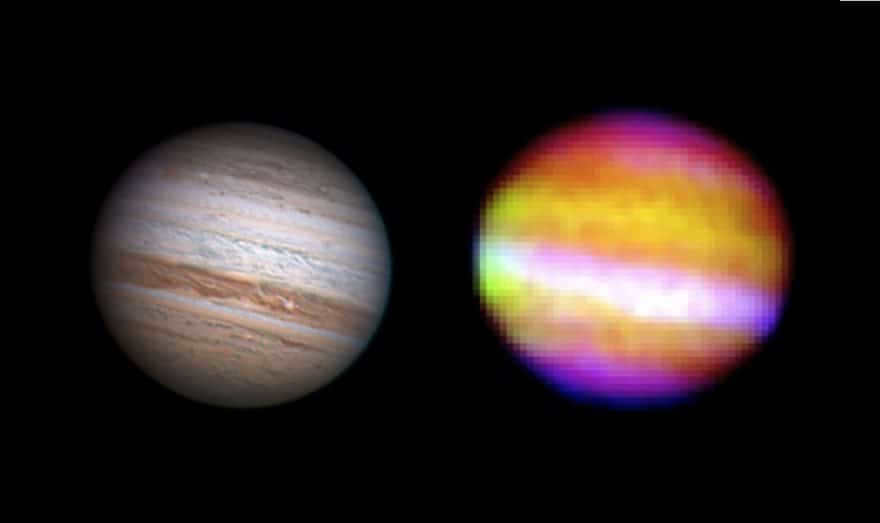
An infrared image of Jupiter was captured by SOFIA.
Subsequently, scientists were able to identify three types of signals: decametric, decimeter, and thermal emissions. The decametric signals vary with the planet’s rotation and are influenced by Io’s interaction with Jupiter’s magnetic field. The decimeter signals originate from the equatorial belt in a torus shape and result from cyclonic electron radiation. The thermal emissions, on the other hand, are produced by the heat in Jupiter’s atmosphere.
Map of the Surface
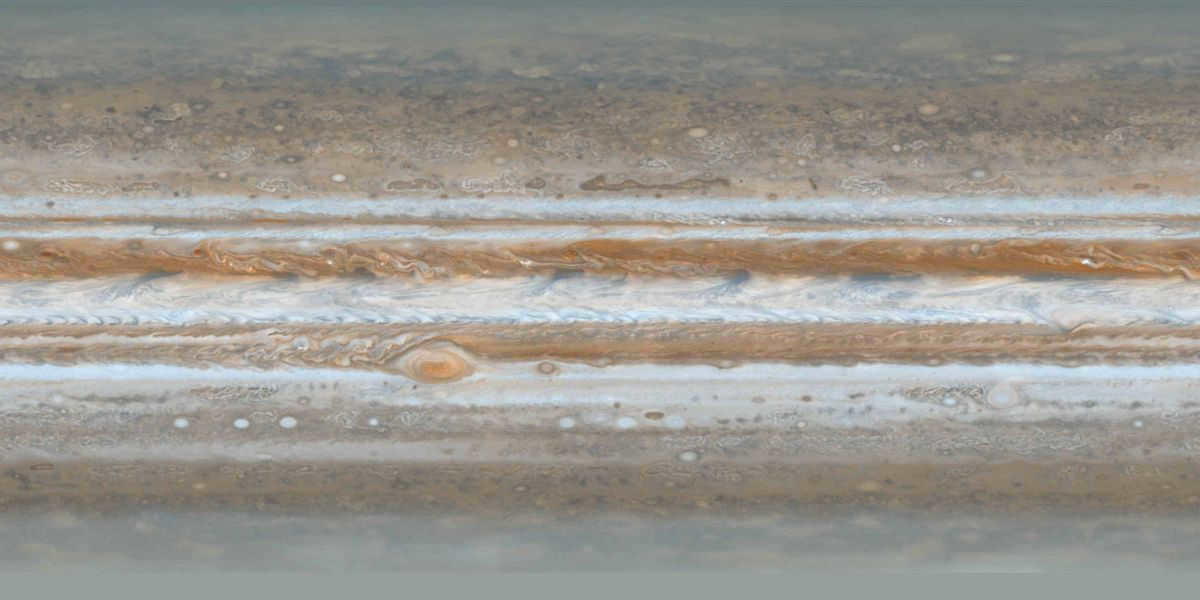

Click on the picture to make it bigger
The position and movement of Jupiter
- Jupiter’s diameter;
- The Great Red Spot;
- Jupiter’s dimensions;
- How many Earths can fit inside Jupiter?
- The composition of Jupiter;
- Jupiter’s core;
- Does Jupiter have a solid core?
- Why does Jupiter have the Great Red Spot?
- Jupiter’s mass;
- A year on Jupiter;
- A day on Jupiter;
- How many rings does Jupiter have?
While Saturn’s rings are widely known, it is worth noting that Jupiter also boasts an impressive array of satellites. Currently, scientists have identified a total of 67 satellites orbiting Jupiter, with 63 of them being extensively studied. However, it is believed that Jupiter may have over a hundred satellites, with the majority of them being discovered in recent years. This is quite remarkable when you consider that back in the late 1970s, only 13 satellites were officially recognized. Thanks to advancements in ground-based telescopes, we have been able to detect over 50 additional satellites.
Although most of Jupiter’s satellites have a relatively small diameter, ranging from 2 to 4 km, astronomers have categorized them into three groups: Galilean, inner, and outer satellites.
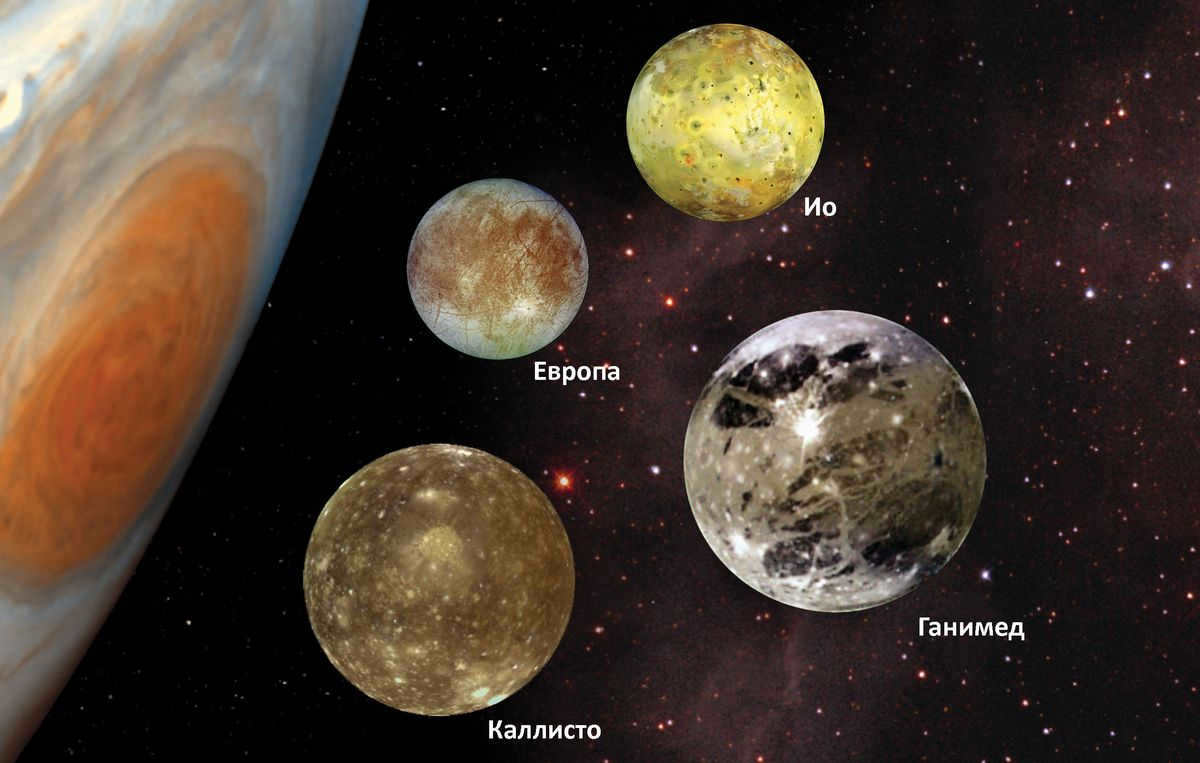
The biggest moons of Jupiter – Io, Europa, Ganymede, and Callisto – were first observed by Galileo Galilei in 1610, and they were named in his honor. These moons formed after the planet had already formed, from the gas and dust that surrounded it.
Io
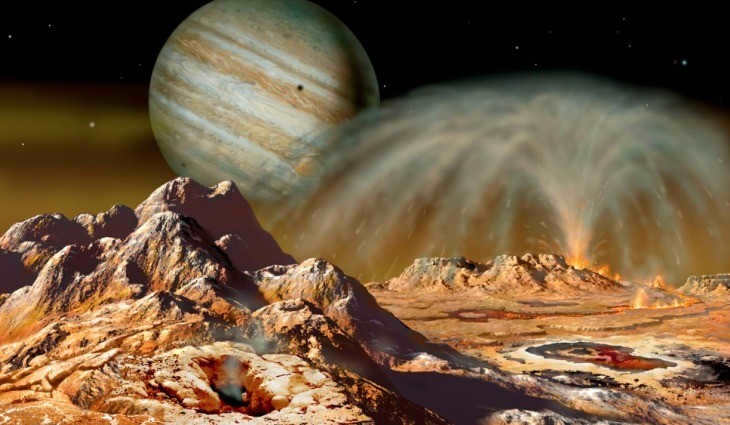
Io was named after the lover of Zeus, making it more appropriate to refer to her in the feminine form. She is Jupiter’s fifth moon and holds the distinction of being the most volcanically active celestial body in our solar system. Io is approximately the same age as Jupiter itself, which is around 4.5 billion years old. Similar to our Moon, Io is tidally locked to Jupiter, meaning only one side of the moon always faces the planet. It has a diameter that is slightly larger than the Moon, measuring at 3642 km compared to the Moon’s 3474 km. The distance between Io and Jupiter is approximately 350,000 kilometers. In terms of size, Io ranks as the fourth largest moon in the entire solar system.
Volcanic activity is exceptionally rare on the satellites and planets in our Solar System. Currently, only four cosmic bodies in our solar system are known to have volcanic activity. These include Earth, Triton (a satellite of Neptune), Enceladus (a satellite of Saturn), and Io, which is the undisputed leader in terms of volcanic activity.
The eruptions on Io are so massive that they can be seen from space. To give you an idea, sulfur magma from Io’s volcanoes can erupt up to 300 km in height (12 such volcanoes have already been discovered). Additionally, the entire surface of Io is covered by giant lava flows, displaying a wide range of vibrant colors. Furthermore, Io’s atmosphere is mainly composed of sulfur dioxide due to its high volcanic activity.
A genuine image!
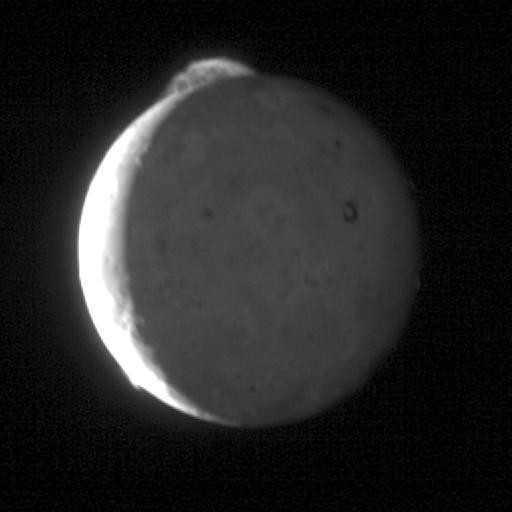
An animated sequence depicting the eruption at Twashtar Patera, composed of a series of five images captured by the New Horizons spacecraft in 2007.
Io, in close proximity to Jupiter (relative to cosmic standards, of course), experiences a profound gravitational influence from its celestial neighbor. This gravitational pull accounts for the immense internal friction within Io, generated by tidal forces, as well as the continuous deformation of the moon’s surface and interior, resulting in the heating of both. In certain regions of Io, temperatures can reach up to 300°C. Additionally, Io is subject to gravitational forces from two other moons, Ganymede and Europa, which contribute significantly to the additional thermal energy experienced by Io.
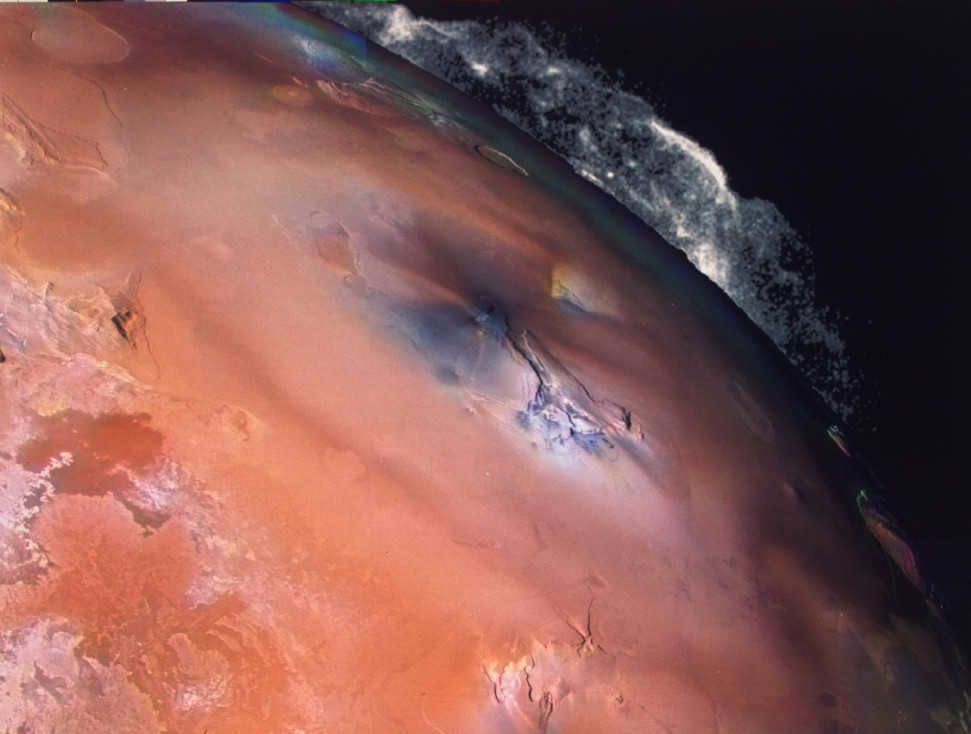
Unlike the volcanoes found on Earth, which are typically dormant for long periods of time and only erupt for short durations, the volcanic activity on the hot moon Io is continuous. This constant activity gives rise to unique rivers and lakes made of flowing molten magma. One notable feature is the largest molten lake discovered so far, which measures 20 km in diameter and contains an island made of solidified sulfur.
However, the relationship between a planet and its moon is not one-sided. In the case of Io and its parent planet Jupiter, there is a reciprocal interaction. Jupiter’s powerful magnetic belts constantly draw matter from Io, taking in up to 1000 kg per second. This influx of matter significantly enlarges Jupiter’s magnetosphere. Additionally, as Io moves through Jupiter’s magnetosphere, it generates tremendous electrical currents, leading to intense thunderstorms in the upper atmosphere of the gas giant.
Europe
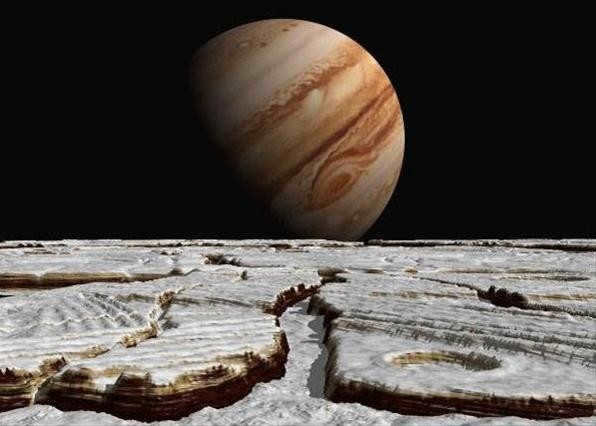
Europa received its name from Zeus after he abducted a Phoenician king’s daughter, who he disguised as a bull. This moon is situated sixth farthest from Jupiter and is approximately the same age, around 4.5 billion years old. However, Europa’s surface is much younger, only about 100 million years old, resulting in a scarcity of meteorite craters compared to Jupiter and its other moons. Scientists have discovered only five craters with diameters ranging from 10 to 30 kilometers.
The distance between Europa and Jupiter is about 670,900 km. Europa’s diameter measures smaller than both Io and the Moon, at only 3100 km, and it always faces the same side towards its planet.
Europa’s equator experiences a maximum surface temperature of minus 160°C, while at the poles, it can drop even lower to minus 220°C. Despite being covered in a layer of ice, experts speculate that beneath its frozen exterior lies a hidden liquid ocean. Furthermore, scientists believe that this ocean might harbor some form of life, supported by thermal springs near subterranean volcanoes, similar to those found on our own planet. When it comes to water, Europa surpasses Earth by a factor of two.
Two perspectives on the composition of Europe
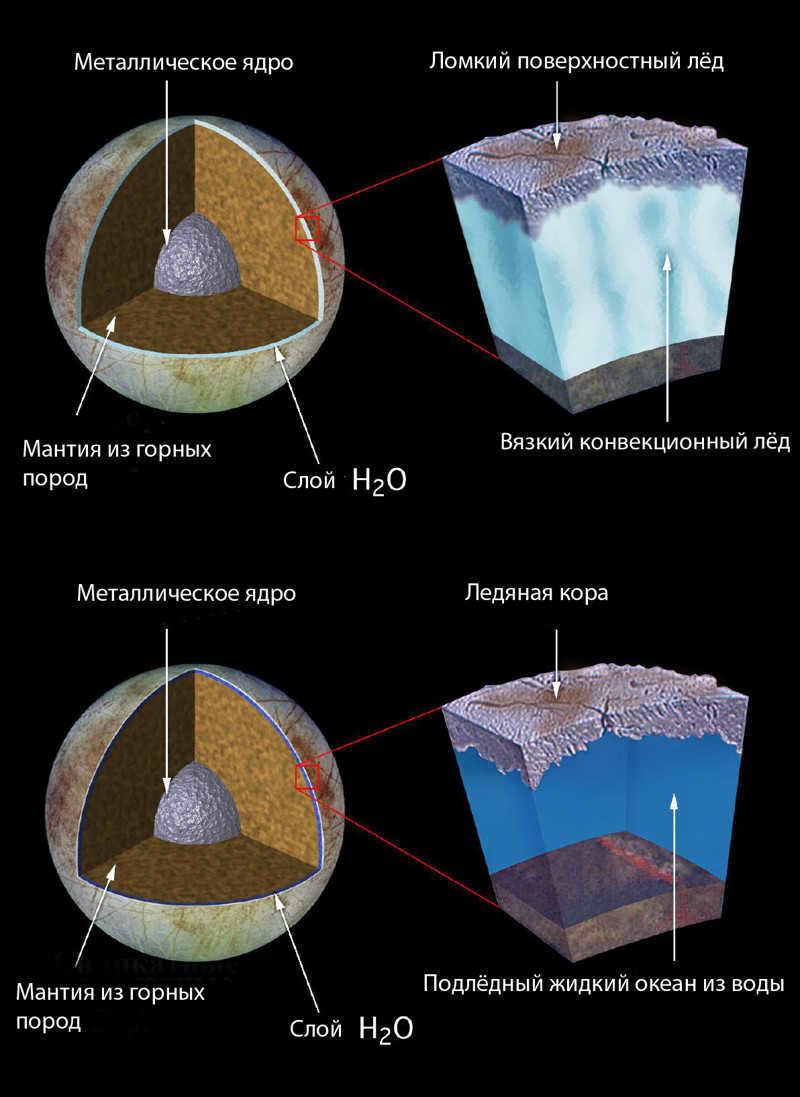
The surface of Europa is marked with fractures. The prevailing theory suggests that these fractures are a result of tidal forces acting on the subsurface ocean. It is likely that the water beneath the icy shell experiences elevated levels as the moon approaches Jupiter. If this is indeed the case, then the appearance of fractures on the surface is directly linked to the periodic rise and fall of the water level.
According to a group of scientists, there are instances when the subsurface water bursts through the icy shell, similar to lava during a volcanic eruption, and then freezes. The presence of icebergs on the moon’s surface supports this hypothesis.
As a whole, Europa is known to possess a surface that lacks any elevations surpassing 100 meters, making it an exceptionally smooth celestial object within our solar system. The atmosphere surrounding Europa is characterized by a scarcity of molecules, with the majority consisting of molecular oxygen. This particular composition is believed to result from the breakdown of ice on Europa’s surface, which occurs as a consequence of exposure to solar radiation and various forms of intense radiation. Consequently, the relatively lightweight molecular hydrogen present on Europa’s surface is rapidly lost into space due to both its inherent lightness and the relatively weak gravitational pull exerted by the moon.
Ganymede
Ganymede was a moon of Jupiter that was discovered by Galileo Galilei in 1610. It is the largest moon in the solar system and is even larger than the planet Mercury. Ganymede has a unique surface that is covered in a mix of craters, ridges, and grooves. It also has a thin atmosphere and a magnetic field. Ganymede is thought to have a subsurface ocean of salty water, making it a potential location for extraterrestrial life. The moon has been studied by several space missions, including the Galileo spacecraft and the upcoming Europa Clipper mission.
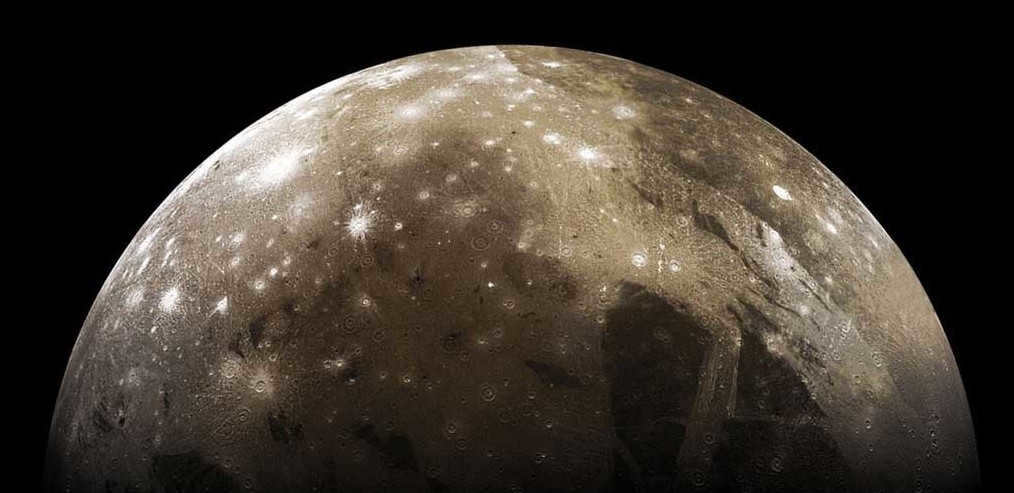
The moon bears the name of the alluring young man whom Zeus transported to Olympus and appointed as the divine cupbearer. Ganymede stands as the largest moon in our solar system, boasting a diameter of 5,268 kilometers. If its path revolved around the Sun rather than Jupiter, it would be recognized as a planet. Ganymede maintains a distance of approximately 1070 million kilometers from Jupiter. This celestial body holds the distinction of being the sole moon in our solar system to possess its own magnetosphere.
An astonishing 60% of its surface is dominated by peculiar ice formations, evidence of dynamic geological processes that occurred 3.5 billion years ago, while the remaining 40% is comprised of an ancient, thick ice crust adorned with numerous craters.
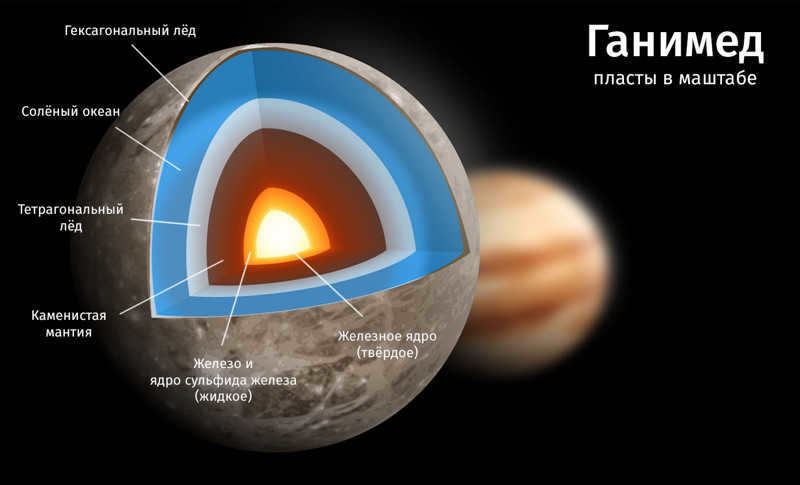
Ganymede has a core and a mantle made of silicate, which generates heat and allows for the existence of an underground ocean. Scientists believe that this ocean is located below the surface, at a depth of around 200 kilometers. In comparison, Europa has a large ocean that is closer to the surface.
While Ganymede’s atmosphere is thin, consisting mainly of oxygen, it is similar to the atmosphere found on Europa. Interestingly, the craters on Ganymede have a unique appearance compared to those on other moons of Jupiter. Unlike the craters on the Moon, Ganymede’s craters are flat and lack a depression in the center. This is likely due to the slow movement of its soft ice surface over time.
Callisto: A Unique Reimagining
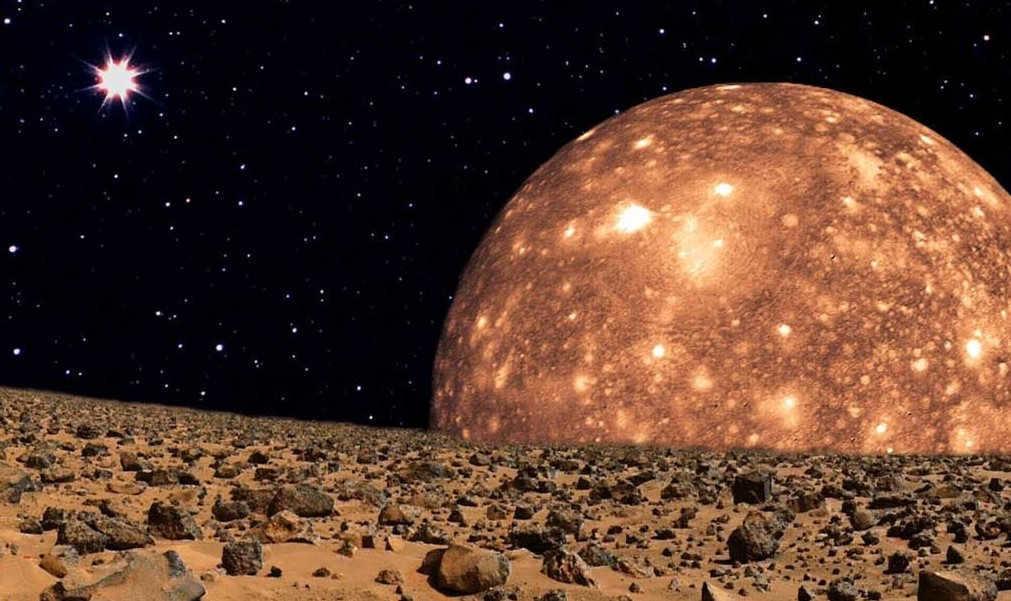
The moon Callisto was given its name in honor of another paramour of Zeus. It measures 4,820 kilometers in diameter, making it the third largest moon in the entire solar system. In fact, Callisto’s diameter is about 99% of Mercury’s diameter, despite the fact that Callisto’s mass is three times smaller than that of Mercury.
Like Jupiter itself and the other Galilean moons, Callisto is also estimated to be about 4.5 billion years old. However, Callisto’s distance from Jupiter is significantly greater compared to the other moons, with a distance of almost 1.9 million kilometers. This distance ensures that Callisto is spared from the intense radiation field of the gas giant.
The Callisto’s surface is known for being one of the oldest surfaces in the entire solar system, with an estimated age of approximately 4 billion years. Its entire surface is characterized by an abundance of craters, indicating that over time, meteorites have consistently fallen into pre-existing impact basins. Due to the absence of any significant tectonic activity and the lack of surface heating since its formation, Callisto has managed to preserve its ancient appearance.
Many scientists believe that Callisto is enveloped by a thick layer of ice, which conceals a hidden ocean beneath. Furthermore, the satellite’s core is believed to consist of rocks and iron. As for its atmosphere, it is known to be composed primarily of carbon dioxide, albeit in a highly rarified state.
One notable feature on Callisto is the Valhalla crater, which has a total diameter of approximately 3,800 km. It consists of a bright central area measuring 360 km in diameter, surrounded by concentric rings with ridges that extend up to 1900 kilometers. This entire formation resembles the ripples created when a stone is thrown into water, except in this case, the “stone” is a large asteroid measuring 10-20 kilometers in size. Valhalla is considered the largest formation of its kind in the entire solar system, despite the fact that the crater itself is only the 13th largest.

As previously stated, Callisto is situated beyond Jupiter’s intense radiation belt, making it a prime candidate (following the Moon and Mars) for establishing a space outpost. The presence of ice on Callisto could provide a valuable water resource, and its proximity to Jupiter’s moon Europa makes it an ideal base for further exploration.
The journey to Callisto is estimated to take anywhere from 2 to 5 years. The first manned expedition is not expected to launch before 2040, and there is a possibility of further delays.
An illustration of the internal composition of Callisto
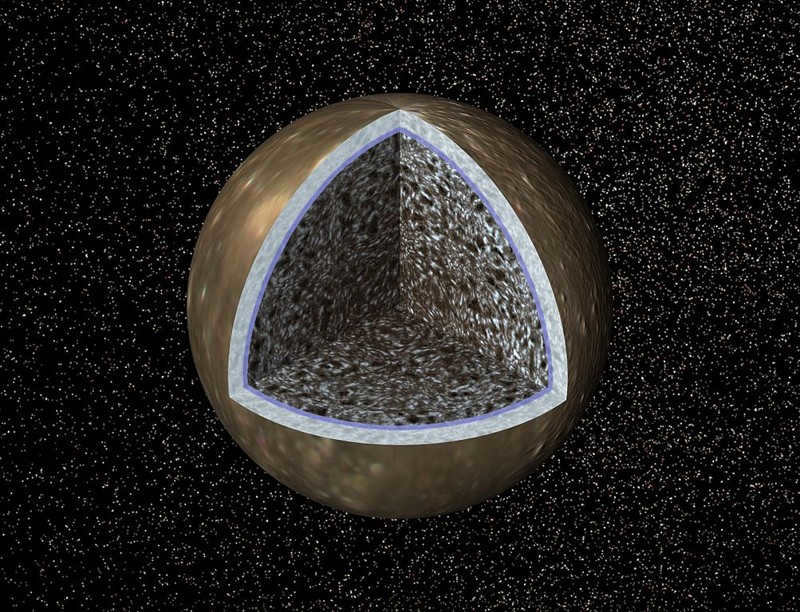
Displayed above is a representation of the internal composition of Callisto, one of Jupiter’s moons. It consists of an icy crust, a potential water ocean, and a central core made up of rock and ice.
The Moons of Jupiter That Are Located in the Inner Region
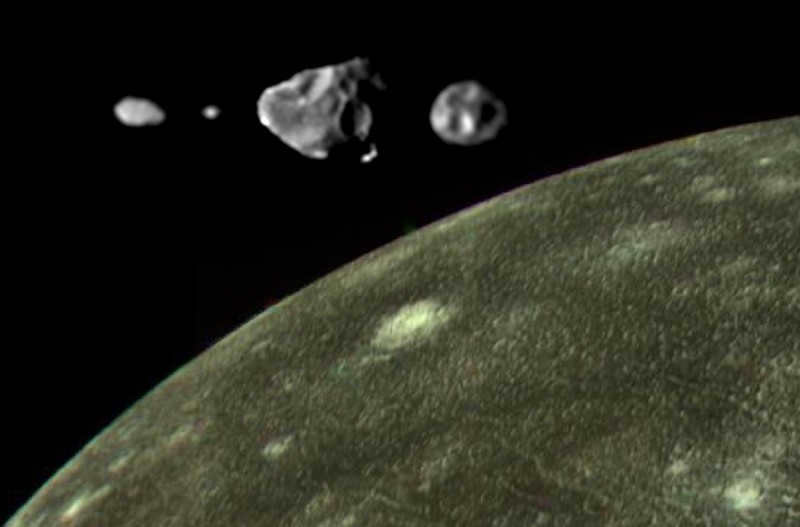

The inner satellites of Jupiter have been given names based on their orbits, which bring them very close to the planet and place them inside the orbit of Io, the closest satellite of Jupiter discovered by Galileo. There are four inner satellites in total, namely Metida, Amalthea, Adrastea, and Thebes.
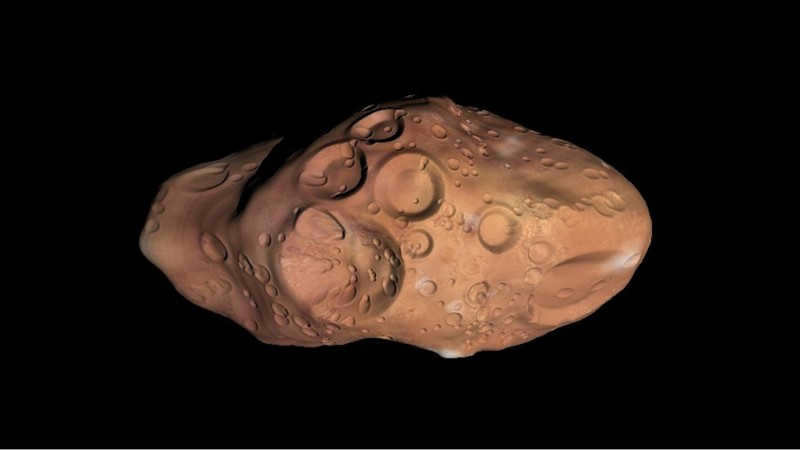
Jupiter’s ring system is sustained and replenished not only by its inner satellites, but also by small inner moons that are currently unseen. Metida and Adrastea support Jupiter’s main ring, while Amalthea and Thebes maintain their own weaker outer rings.
Out of all the inner satellites, Amalthea is the most fascinating due to its dark red surface. This feature is unique in the solar system, and scientists speculate that it may be caused by inclusions of minerals and sulfur-containing substances in the icy surface. However, the exact cause of this coloration remains unclear. It is possible that Jupiter captured Amalthea from outside the solar system, as is often the case with comets.
Outer moons of Jupiter
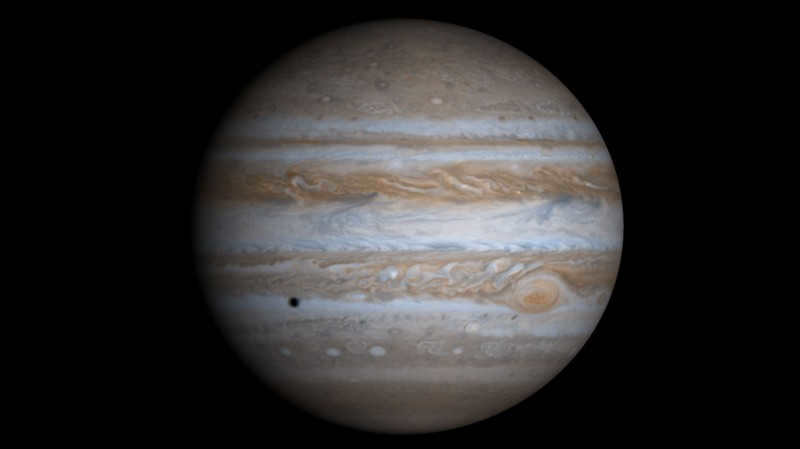

The group of satellites located farther away from Jupiter is composed of smaller satellites, varying in size from 1 to 170 km. These satellites follow elongated orbits with a significant inclination towards Jupiter’s equator. Currently, there are 59 known satellites in this outer group. In contrast to the inner satellites, which orbit in the same direction as Jupiter’s rotation, the majority of the outer satellites orbit in the opposite direction.
Paths of Jupiter’s Moons

Due to the remarkably similar orbits of certain small satellites, it is believed that they are the remnants of larger satellites that were destroyed by the powerful gravitational force of Jupiter. When observed from passing spacecraft, these satellites appear as amorphous clusters. Evidently, Jupiter’s gravitational field ensnared these satellites while they were traversing freely through the vast expanse of space.
Rings of Jupiter
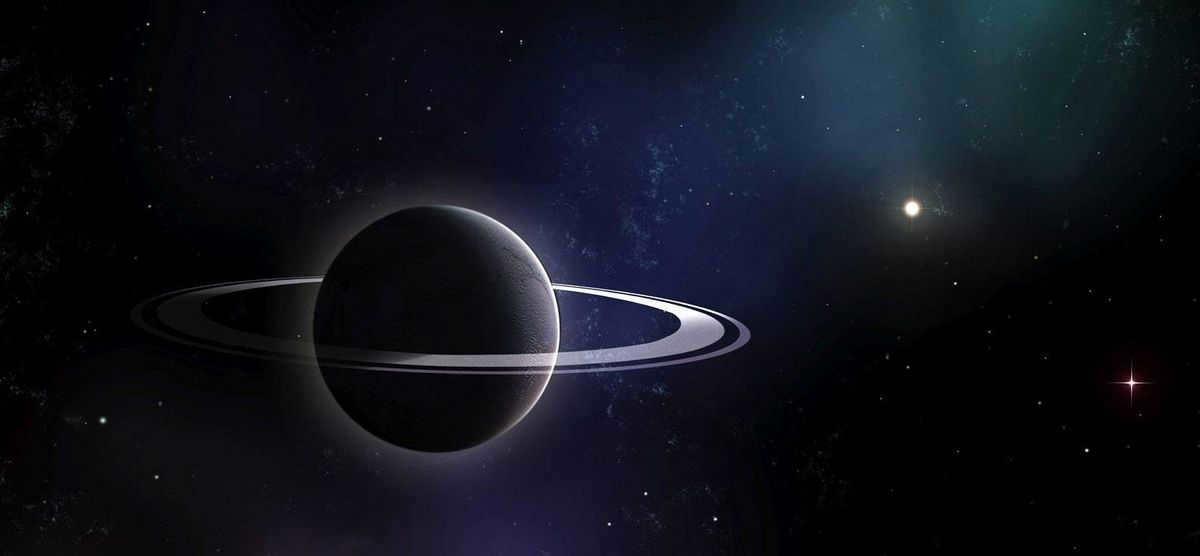
Jupiter, like Saturn, Uranus, and Neptune, has its own system of satellites. However, unlike Saturn’s magnificent and visible rings made of shiny ice, Jupiter’s rings are relatively minor and dusty in structure. This is why they were not discovered until the 1970s when spacecraft first reached Jupiter’s system.

The ring system of Jupiter is composed of four primary elements:
1. The halo, which is a thick torus of particles that has a resemblance to a donut or a disk with a hole in it.
2. The main ring, which is extremely thin and highly luminous.
3. Two outer rings, known as “spider rings,” which are broad but have a faint appearance.
The halo and the Main Ring are primarily made up of dust from Metida, Adrastea, and possibly several other smaller satellites. The halo has a width of approximately 20 to 40 thousand kilometers, although the majority of its mass is within a few hundred kilometers from the ring plane. The shape of the halo is believed to be influenced by electromagnetic forces within Jupiter’s magnetosphere acting on the dust particles in the ring, as per a popular hypothesis.
Spiderweb rings are characterized by their thin and transparent appearance, resembling the delicate structure of a spider’s web. They derive their name from the material that composes them, namely Amalthea and Thebes, Jupiter’s satellites. In contrast, the outer boundaries of the Main Ring are defined by the satellites Adrastea and Metis.
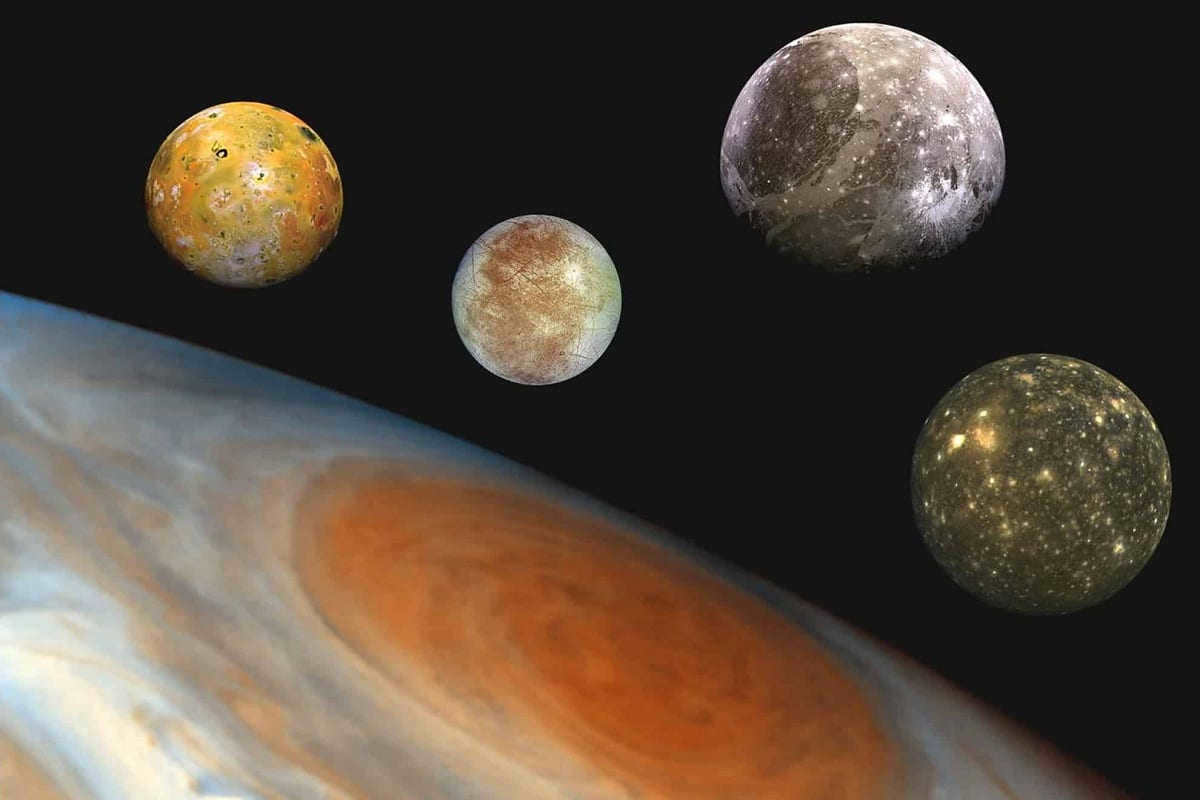
It is common knowledge that Jupiter holds the title of being the largest planet within our solar system. Extensive research and observations have been conducted in order to identify and study the numerous natural satellites that orbit around Jupiter. As of now, scientists have confirmed the existence of 79 moons revolving around this magnificent planet. These natural satellites are commonly referred to as moons and they are celestial bodies that orbit around a planet. Out of all the planets in our solar system, only 6 have been found to possess natural satellites, with the exceptions being Mercury and Venus.
Within this article, we will delve into the various characteristics and significant discoveries that have been made regarding the satellites of Jupiter.
Distinctive Features of Jupiter
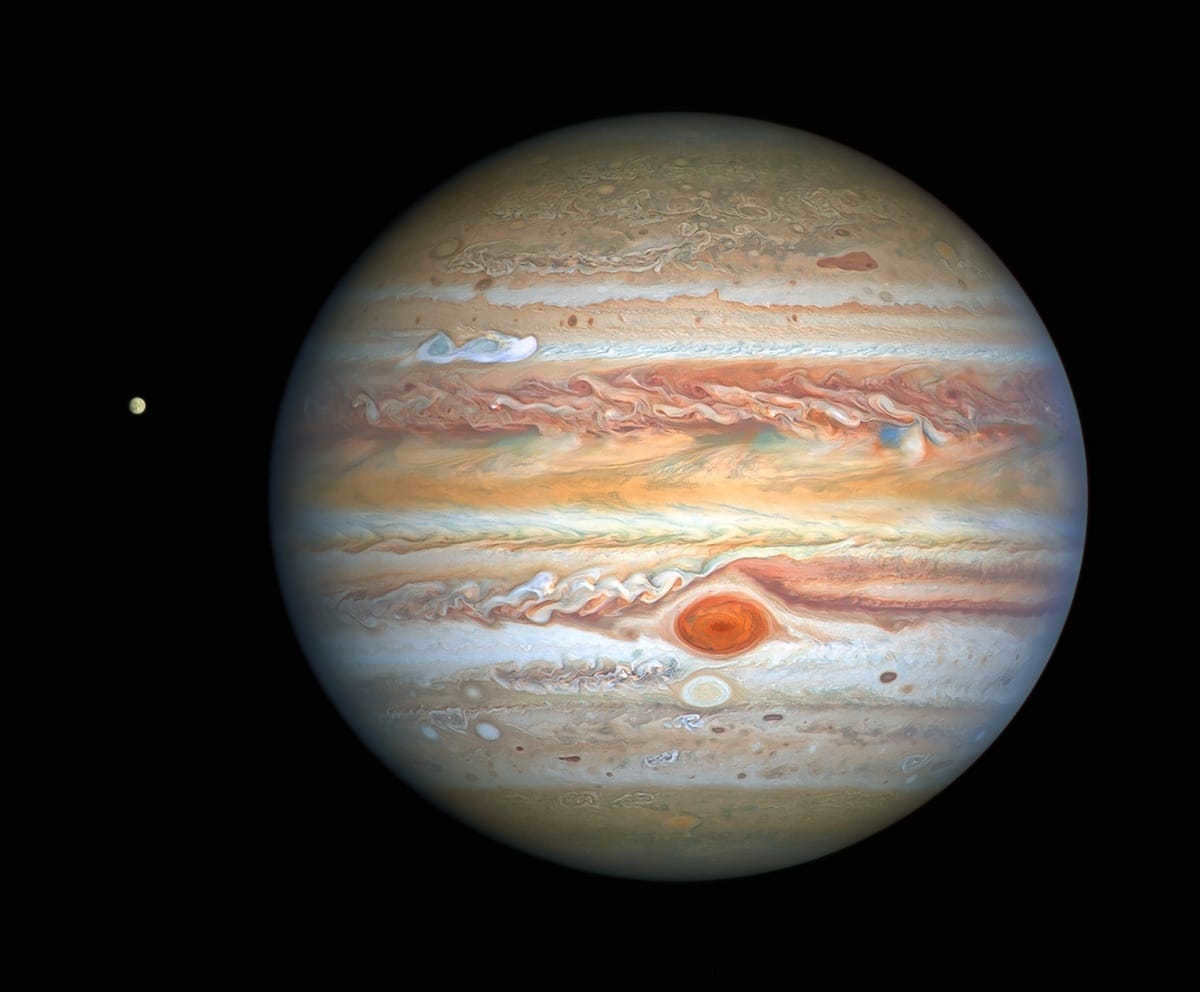
Jupiter has a density that is approximately one-fourth of Earth’s density. However, the majority of its interior is composed of gaseous elements like hydrogen, helium, and argon. Unlike Earth, there is no distinct boundary between Jupiter’s surface and its atmosphere. This is due to the gradual transition of atmospheric gases into liquid form.
The immense pressure on Jupiter causes hydrogen to exist in a metallic liquid state, a phenomenon that does not occur on our planet. The planet’s interior remains largely unexplored, making it unclear what materials comprise its core. Scientists suspect that it consists of rocky substances, possibly in the form of ice due to the extremely low temperatures.
In 2013, the two planets were separated by a minimum distance of 590 million kilometers. However, it is worth noting that these planets can also be located at a maximum distance of 676 million kilometers.
The Moons of Jupiter
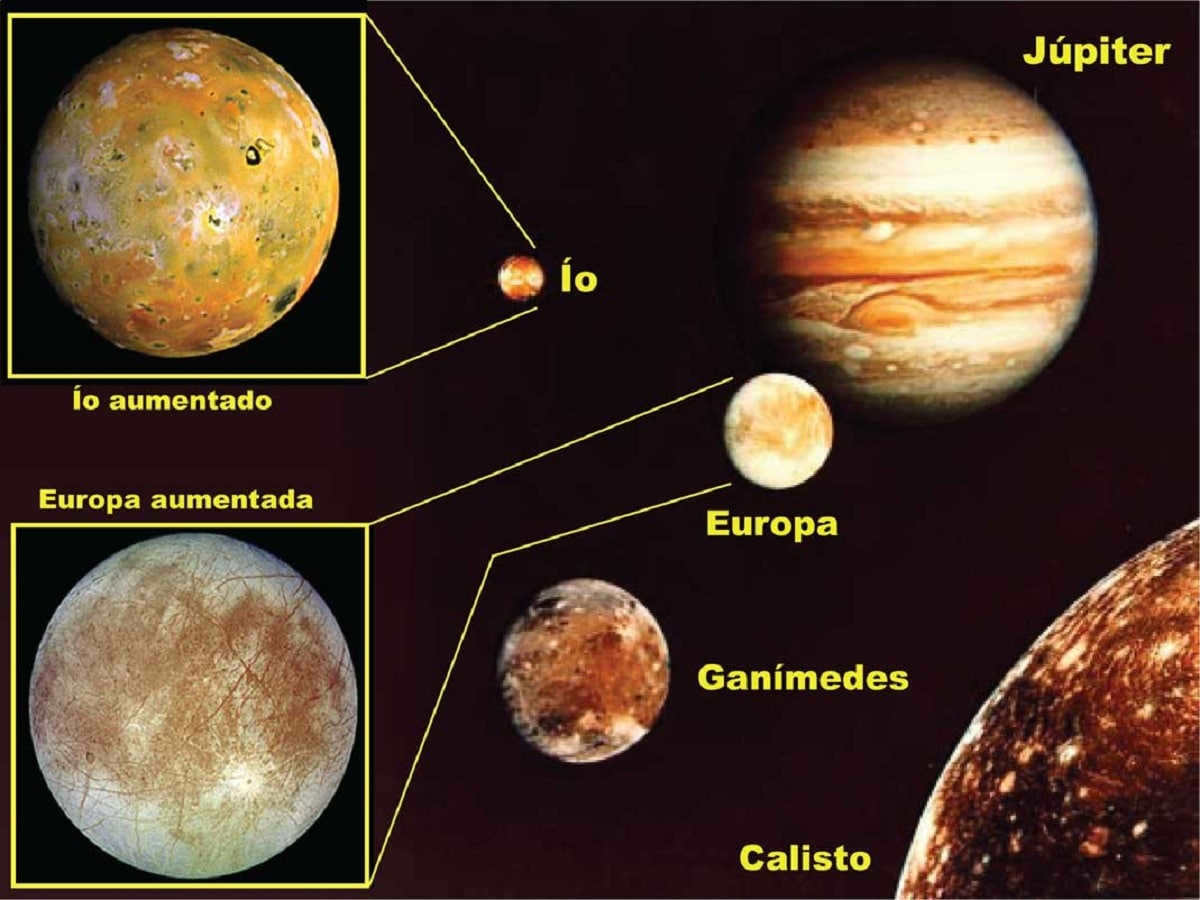
Since the start of this year. Starting from 1892 up until now, there have been a total of 79 known satellites of Jupiter. Over time, astronomers have been able to discover these satellites one by one and gather information about their characteristics. They have been named after the lovers and daughters of the deity Jupiter. These satellites can be categorized into two main groups: regular and irregular. The regular group consists of the Galilean moons, while the irregular group includes the prograde and retrograde satellites. Among these, there are 8 regular satellites, all of which have a direct orbit. This means that their orbital motion is in the same direction as the rotation of the planet. It’s worth noting that not all satellites have a spherical shape, as some of them are completely irregular in form.
There is a belief that the satellites were formed through the process of a periplanetary disk, which is a ring of gas accretion and solid fragments similar to a protoplanetary disk that surrounds a star.
Continuing with the categorization, there are irregularly shaped satellites, which are smaller and located further away compared to regular satellites. These satellites have various types of orbits. Within this extensive group, there are satellites with an orbit that follows a straight path. In the classification of irregular satellites, there are also other groups. One of them is the Himalia group, which consists of satellites of Jupiter that have similar orbits and are named after the largest moon in that region. The reason for its name is that Himalia has a diameter of 170 kilometers, whereas Listea, Leda, and Elara have diameters of 36, 20, and 80 kilometers, respectively.
Next, we have a separate category within the irregular moons known as the retrograde moons. These moons are called retrograde because their orbit is in the opposite direction of Jupiter’s rotation. This group consists of all the remaining moons up to moon number 79.
The primary moons of Jupiter
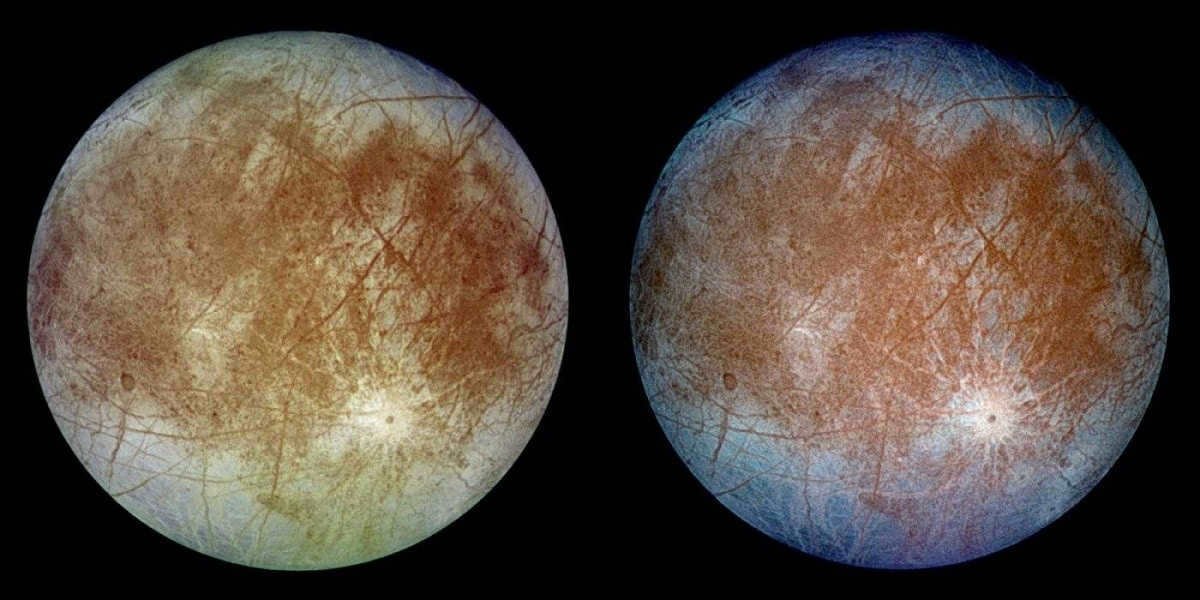
Jupiter has four primary moons known as the Galilean moons: Io, Europa, Ganymede, and Callisto. These four moons, which are considered ordinary moons, can be observed from Earth using a telescope.
This is the nearest and most compact moon of the Galilean satellites. Here we can discover incredibly vast plains and other mountain ranges, yet it lacks any crater caused by the impact of a meteorite. Due to its absence of craters, it is believed to have a relatively young geological age. In fact, it boasts more than 400 active volcanoes, making it the most geologically active celestial object in the entire solar system.
Notably, it possesses a minute, exceedingly thin atmosphere that contains sulfur dioxide among other gases. Additionally, its close proximity to the planet and the resulting effect has led to a scarcity of water on this moon.
Moon Europa
Europa, the smallest of the four major moons, possesses an ice crust and a core likely made up of iron and nickel. Its atmosphere, fragile and sparse, is primarily composed of oxygen. The surface of Europa is remarkably smooth, leading scientists to theorize the existence of an underground ocean that could have fostered the development of life. Due to this possibility, Europa has emerged as the most captivating satellite in the entire solar system for further exploration.
Satellites of Jupiter: The Moon Ganymede
Ganymede, the largest satellite in the entire solar system, stands out from the rest due to its possession of a unique magnetic field. With a size twice as big as our moon, it also shares a similar age. Composed primarily of silicates and ice, Ganymede’s core is dense and iron-rich. Scientists believe that there might be an inner ocean within Ganymede, capable of holding more water than all the oceans on Earth combined.

